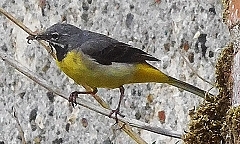Adam Yamey's Blog: YAMEY, page 121
July 2, 2022
Holes in a brick wall
WALKING PAST UNIVERSITY College School (‘UCS’) in Hampstead’s Frognal, I spotted something that reminded me of my schooldays, both at the Hall School (in Swiss Cottage) and Highgate School (…in Highgate!).
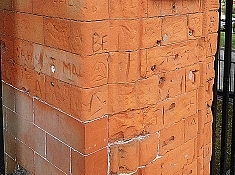
A part of the brick wall enclosing the grounds of UCS is inscribed with initials. Some of the bricks also have circular depressions. Those which have not been filled in have interiors which are parts of spheres. The bricks on the walls of the schools I attended used to be spotted liberally with similar circular, spherical concavities.
The concavities, which are never more than about 1.5 inches in diameter, were created using the edges of coins. If the edge of a coin is placed firmly against a brick and the twisted left and right repeatedly, the sharp coin gradually wears away the brick and creates a concavity as described.
In the days long before mobile telephones were even the stuff of dreams, mining out brickwork and inscribing one’s initials provided a perfect way for school kids to pass a few idle moments and to leave one’s mark.
Read more about Frognal and the rest of Hampstead in my new book available from https://www.amazon.co.uk/dp/B09R2WRK92
July 1, 2022
The wind
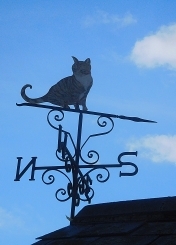 Weathervane in Thaxted, Essex
Weathervane in Thaxted, EssexWhich way will it blow?
The wind of war brings fear and rage
Let peace reign soon
June 30, 2022
Asleep in his armour
ENGLISH PARISH CHURCHES are full of surprises. The church of St Mary the Virgin in the Essex village of Hatfield Broad Oak (once known as ‘Hatfield Regis’) is no exception. Its nave is a surviving remnant of a Benedictine priory founded in 1135 by Alberic De Vere (c1085-1141) The highlight of this church is a recumbent stone effigy of Alberic’s grandson, Robert de Vere, 3rd Earl of Oxford (c1155-1221), who was born in Hatfield Broad Oak. He was one of the barons who forced King John into signing the Magna Carta at Runnymede in 1215. The effigy was placed in the church either by his son or his grandson. It lies on the floor of the chancel in front of the nave and close to the high altar. Whereas in many churches, there is an unobstructed view of the altar (or a rood screen) from the western end of a church, Robert’s effigy sticks out like a sore thumb when you are looking along the length of the nave
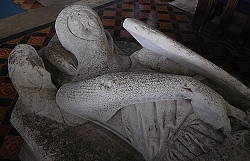
The effigy, which is in remarkably good condition given its age, depicts Robert lying with his legs crossed. His right hand clutches a sword and there is a shield attached to his left arm. His left foot rests on something that is not easily identifiable as it has been damaged. What is most remarkable about this funerary sculpture is that Robert is almost entirely clad in chain mail. Part of his face peers through a circular gap in the armoured head dress. The carver of this monument took great pains to show the chain mail in fine detail. For me, this is what makes the effigy quite wonderful.
Fascinating as is the effigy, Robert’s family interested me because of its connection with Kensington in London. Robert’s great grandfather Alberic (or Aubrey) De Vere (1040-1112) was a tenant-in-chief of William the Conqueror. The Domesday Book records that he was a great landowner with properties in nine counties. One of these was the manor of Kensington in the County of Middlesex. His name is remembered today in the Royal Borough of Kensington and Chelsea by the street name Aubrey Walk, which leads to Aubrey House, currently a private residence.
The day before we visited Hatfield Broad Oak, we were in Coggeshall (Essex), where I spotted a memorial to a protestant martyr, Thomas Hawkes (see: https://adam-yamey-writes.com/2022/06/26/burnt-rather-than-baptised/), who had worked for the De Vere family. Had Hatfield Broad Oak not been such a pretty village, I doubt that we would have stopped there. That would have been a pity because then we would have missed seeing the chain mail clad effigy and its interesting connection with a part of west London, with which I am quite familiar.
June 29, 2022
A bird nearby
June 28, 2022
Eating afer 9 pm in a village in Essex
WHILE ELTON JOHN was performing in front of thousands in London’s Hyde Park in late June 2022, a small ensemble was performing works by the baroque composers Pergolesi and Purcell in the large medieval gothic church in Thaxted (Essex). The superbly performed concert in Thaxted starring the Armonico Consort ended well after 9 pm. This was not a problem for the many well-healed members of the audience in the church, who lived locally and were able to feed themselves in their own homes.
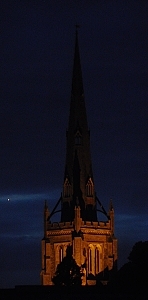 Thaxted, Essex
Thaxted, EssexWe could have eaten before the concert, which commenced at 7 pm, but were not hungry before that early hour. The pubs in Thaxted informed us that their kitchens stopped taking orders for food before 845 or 9 pm.
At a pub called the Star, someone hearing us asking about food after 9 pm, recommended we should head for Farouk’s. The bar attendant and several bystander’s agreed with our informant. The bar attendant kindly said that we could bring food from Farouk and she would save a table for us at which we could sit and eat after the concert.
Farouk is the owner of a caravan parked in a yard behind a petrol filling station in Thaxted. He and his colleagues, all from Turkey, prepare and sell Turkish food in the caravan. And, his eatery closes not at 845 or 9 pm, but at 11 pm.
After hearing superb renderings of Pergolesi’s “Stabat Mater” and Purcell’s “Dido and Aeneas” (semi-staged), we headed for Farouk’s caravan and the Star pub.
While waiting for our food to be prepared at about 9.40 pm, Farouk explained he had come from Gaziantep. He said that in his part of Turkey, which is quite close to Cyprus, Turkish is spoken with an accent that is very similar to that spoken by Cypriot Turks. During the ten minutes it took to prepare our food, Farouk took many food orders over the phone, which goes to show that in Thaxted there is a healthy demand for food after 9 pm.
We enjoyed our food at the table reserved for us at the Star. This welcoming pub is popular with locals. I suspect that its lively clientele was a different segment of Thaxted’s population from that which attended the concert in the church.
June 27, 2022
Small but beautiful: deserves a visit
WHEN PEOPLE CONSIDER picturesque places in the eastern English county of Suffolk, the following places usually spring to mind: Bury St Edmunds, Clare, Southwold, Lavenham, Long Melford, and Sudbury. All these places deserve their reputation as sites worth visiting. Kersey is another place, which is exceptionally attractive. I had never heard about it until someone in a museum (in Essex) told me about it recently. It is far less visited than those mentioned above.
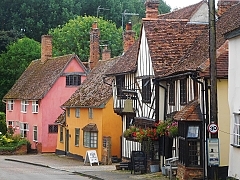 Kersey, Suffolk, England
Kersey, Suffolk, EnglandKersey is about 9 miles west of Ipswich. The village lies on the steep slopes of the valley of a small stream, a tributary of the River Brett (which feeds the River Stour). The main road running through Kersey crosses the stream not over a bridge but by a ford (known as ‘The Splash’). The village’s name, Kersey, means a ‘wet area with cress’. It is likely that this refers to the part of the place around The Splash. The heyday of the village was long ago: it was during the 14th century when Kersey was important in the then flourishing woollen cloth production industry. The church overlooking the village, St Mary’s, dates from that prosperous era. Likewise, with many of the lovely half-timbered houses. Although their construction began in the 14th and 15th centuries, they have undergone modifications over the centuries. However, they have a picturesqueness that easily rivals that which has made the better-known places (listed above) so famous.
Apart from the church and the half-timbered Bell Inn (about 14th century), one building stands out in Kersey. This is a large building with an impressive 16th century two storeyed red brick entrance structure projecting from the rest of the edifice, which was constructed in the 15th century. Above the main entrance, there is an inscribed stone plaque set into the brickwork. It bears the following: “Ye Olde River House 1490”.
After the Black Death (1346-1353) and later the decline of the wool industry in that part of Suffolk (in about the 17th century), not much happened in Kersey between then and the present, so I was told by a local inhabitant. Nothing much replaced the textile trade, and this led to the village remaining much as it was during its best days. This is lucky for those, like me, who enjoy the charm of England’s older and eye-catching vernacular architecture. Neither I nor the inhabitant with whom I spoke could understand why Kersey, unlike places such as I mentioned at the start of this piece, is not as frequently visited by tourists. Although smaller than all the other places, it easily matches their beauty.
June 26, 2022
Burnt rather than baptised
COGGESHALL IN ESSEX is an attractive place to visit. The small town contains over 300 buildings of historical interest, all of which have given protected status. Amongst these is Paycockes House, which I will describe another day. One of the many other old buildings in the centre of the town is a large house, once the home of Thomas Hawkes.
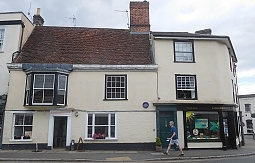 House of Thomas Hawkes in Coggeshall
House of Thomas Hawkes in CoggeshallHawkes was a retainer of John de Vere (1516-1562), the 16th Earl of Oxford, who became a supporter of the Roman Catholic Queen Mary, who became the monarch in 1553 (following the deaths of the Protestant King Edward VI and the unfortunate Lady Jane Grey). Mary decreed that England should return to Roman Catholicism and the Earl of Oxford concurred with this.
Thomas Hawkes, a fervent Protestant, decided to leave his ‘employer’, who had become sympathetic to Mary’s religious cause. He returned to his home (known as ‘Constantynes’) in the centre of Coggeshall. Unwilling to partake in any Roman Catholic practices and a vocal opposer of that branch of Christianity, Hawkes soon became regarded as heretic by the Catholic authorities.
Under great suspicion by those then in power, Hawkes did something that got him into really bad trouble: he refused to have his newly born son baptised into the Catholic faith. He was arrested and taken to Newgate Prison in London. From there, he was taken to the palace of Bishop Edmund Bonner (c1500-1569) several times, and asked to recant. Having refused each time, on the 9th of February 1555, Bonner condemned him to be burnt at the stake. After Bonner had given him one last chance to recant, he is believed to have said:
“No, my lord, that I will not; for if I had a hundred bodies, I would suffer them all to be torn in pieces, rather than I will abjure or recant.” (https://coggeshallmuseum.org/thomas-hawkes/)
After some months, Hawkes was taken to Coggeshall, where on the 10th of June 1555 he was burnt at the stake.
Hawke’s house still stands and is marked with a commemorative plaque. It was built in the mid-15th century, but has been much modified since then.
June 25, 2022
Dwarfed by a cruise ship
DURING THE ELEVEN days we spent in Funchal, the capital of Madeira, the city was visited by two enormous cruise ships. Resembling huge blocks of flats (apartments, my North American friends!) floating on water, they arrived in the port at night, remained a whole day, and then departed the next evening.
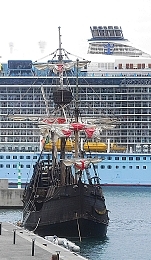
When these vessels disgorge their cargos of tourists, the centre of Funchal becomes crowded; the queue t the cable-car grows longer; and the frequency at which toboggans slide down from the Monte increases.
The port at Funchal is designed to accommodate these ‘humungous’ people carriers, so their arrival does not have the same damaging effect (on buildings and the shoreline) as is created by them in Venice (Italy). Cruising in vessels of this size appeals to many but not to me.
June 24, 2022
When the writing is over, the hard work begins
I HAVE BEEN working on the manuscript for a new book, which I plan to publish. I will not reveal what I am writing about … at least, not yet!
As I have been doing for the last few years, I write my text on Microsoft Word, and then re-read it several times, revising and correcting errors of fact, spelling, and grammar. At this stage, I am not too fussed about formatting because this has to be done using other software.
To upload a manuscript to publishers like lulu.com and Amazon KDP, it is best – if not essential – to prepare the final manuscript as a formatted .pdf file. The characteristics of the file need to match what will eventually appear on the printed page. Currently, I am using Serif’s Affinity Publisher software, which is a bit fiddly at first, but it does not take long to get used to it (there are many useful tutorial videos on-line) Using a preformatted template appropriate to the size of book to be produced, I flow my Word text into the Affinity software.
 Screenshot from my Affinity Publisher
Screenshot from my Affinity PublisherOnce it is in the software, each page shows what will eventually appear on each page of the finished book. Using Affinity, I can add illustrations, add page numbers (which change if additional pages are added), an index, and more. I can also edit my text further and shift the formatting of the pages and the spaces between paragraphs to suit me. This stage of the book production is time-consuming but important.
When, eventually, I am happy with what I have produced, I can export the entire book as a .pdf file. This can then be uploaded to the printer’s website, be it lulu.com, Amazon, or another.
Although the writing can be difficult at times, the final formatting of the book to produce a suitable .pdf, which will ensure that everything is in the right place in the printed book is quite demanding but worthwhile at the ‘end of the day’.
June 23, 2022
Amongst the agapanthus
We visited Funchal in Madeira in early June 2022. Although we were recommended to visit some of the numerous botanical gardens in and around the city, it was hardly necessary. I do not think that I have ever visited a place filled with such a profusion of flowers as is the case for Funchal. The whole city seems to be one great garden.
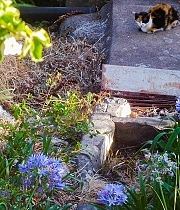
During our visit, we were in time to see a vast number of blue flowered agapanthus plants. Although they are commonly known as ‘lily of the Nile’ or ‘African lily, they are not of the lily family. They are members of the Asparagales order of plants, a part of the Asparagus genus. Had I not seen so many of these flowers in Funchal, I might never have bothered to find out anything about them. As the saying goes, travel broadens the mind.

